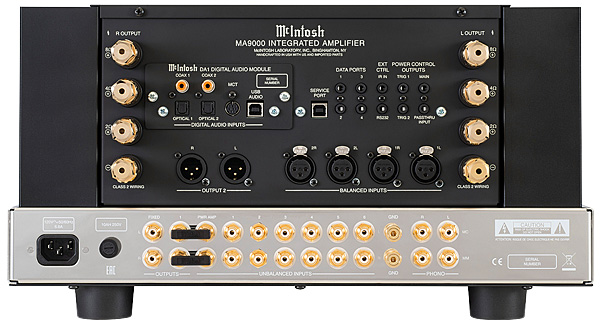McIntosh MA9000 integrated amplifier/DAC

 Billed as McIntosh’s most powerful integrated amp to date, the mighty MA9000 combines transistors with transformers and a ‘blue’ aesthetic that’s truly timeless
Billed as McIntosh’s most powerful integrated amp to date, the mighty MA9000 combines transistors with transformers and a ‘blue’ aesthetic that’s truly timeless
Right, let’s get the ‘and fries to go’ thing out of the way first. If ever a product deserved the title, this is the ‘Big Mac’. Or at least ‘Big Mc’, for the McIntosh MA9000 is huge in every respect, from the sheer bulk of the thing – at least by the standards of most integrated amplifiers – to the 45.8kg fighting weight, increasing to 60.8kg packed, and the £12,995 price tag.
It’s also the most powerful McIntosh integrated amp to date, sharing with its MA8000 stablemate a conservatively-rated 300W output – here, thanks to the use of ‘Autoformers’ in the output stage, consistent whether into 2, 4 or 8ohm loads [see PM’s Sidebar and Lab Report]. Even from a company not known for being shy or reserved when it comes to its products, the MA9000 is something of a brute, and clearly intended as a viable alternative to a conventional high-end pre/power combination.
Chock-A-Block
The styling is either retro-cool, with the classic blue McIntosh meters prominent in the glass-fronted panel, or relentlessly in your face, from the massive ‘grab handles’ – more cosmetic than of much actual use when wrangling the thing into place – to the scattergun of switches and controls across the fascia. Meanwhile the ‘lidless’ design reveals the construction of the amplifier. Indeed, behind the impressive frontage this is more of a polished stainless steel chassis on which sit the various ‘building blocks’ involved. These even extend to the heatsinks which are not run-of-the-mill structures but, as the company puts it, ‘McIntosh Monogrammed Heatsinks … so efficient at dissipating heat that they warrant bearing the McIntosh “Mc” logo’.

There’s a lot of that trademarked stuff going on here, from the Sentry Monitor protection circuitry to the gold-plated Solid Cinch speaker outputs. But the most striking aspects of the amplifier – aside from the size, which I think I may have mentioned – are the unusual equaliser controls ranged across the front and, to the rear, the digital input section on the ‘upper deck’, above the chassis-mounted array of analogue ins and outs.
The eight-band equaliser is entirely analogue in operation, and can be called into play or bypassed using one of the five rocker switches on the fascia. The digital section here is entirely modular, and designed to be swapped out at a later stage if technology – or should that be fashion? – in digital audio changes.
In other words, rather than being deeply embedded in the fibre of the amplifier, the digital inputs stand alone as a discrete unit, and they merely feed into the main part of the MA9000. Two coaxial and two optical digital inputs are provided, along with a USB Type B ‘computer audio’ input, plus a whole load of other connections for custom installation applications. There’s also a multi-pin MCT input for use with the company’s MCT500 transport, allowing a secure connection for the transmission of SACD data, for example.
Dacs 'N' Drivers
The digital section itself is based round an eight-channel 32-bit DAC, run in dual-differential mode, and able to handle up to 192kHz/24-bit via the conventional digital inputs, or 384kHz/32-bit PCM (inc. DXD) and DSD256 using the USB input. As is usual, a driver will be needed for Windows computers to use the USB connection, but none is needed to connect to a Mac. Meanwhile, the analogue department affords two sets of balanced XLR ins, six line-ins on RCAs, and separate MC and MM phono inputs with user-adjustable loading.
Jumper bars allow the preamp and power amp sections to be separated if required; there’s a fixed line output and a ‘home theatre’ unity gain bypass option; and a single set of speaker outputs for each channel, with 2ohm, 4ohm and 8ohm taps. Front panel switches can be used to turn on or off the amp’s speaker and preamp analogue outputs.

























































